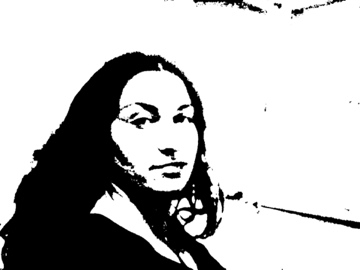From Selfie to Self in T.G. Nili’s Digital Photography
It is the reductionist black and white colour palette that allows us to focus on the digital image processing in T. G. Nili’s photographs. Using exclusively Apple software for the technique of creating by erasure, specifically developed by her for this purpose, Nili’s digitally edited selfies embark on a long journey of discovery of an alter-ego. The artistic gesture of shooting a selfie, in Nili’s attitude, tackles strategies of effacement, concealment and ultimate reduction. Far from digital self-indulgence, her feministic practice is informed with attention to detail attempting to transform a selfie into a portrait of someone other than self. Her approach explores the possibilities of representation of herself and the notion of otherness, suggestive of disappearance beyond self-recognition by researching the basic visual patterns that bridge the gab between oneself, one’s selfie and the other.
Attempting to be someone other than self, even in one’s own selfie, is an ironic comment on the female role in contemporary visual culture, irrevocably connected with Web 2.0 patterns of representation. Being a female in contemporary society is always about being someone other than self – with a selfie as the best digitally possible means of expression. Nili’s work puts it as clear as black and white. The patterns, circuits, rasters visual or cultural imply the psychology of presentation, questioning the techniques of photographic representation, analysing the social circuits of connection and disconnection where “self” disappears beneath the selfie, influenced by role-models, style icons, celebrities that each selfie strives to re-enact.
Citations of famous, immediately recognisable female portraits puts Nili’s practice within a broader art historical theoretical framework. As media theorist Prof. Dr. Wolfgang Ernst points out, Nili’s oeuvre is “media-archaeological ‘image analytics’ ..., that is possibly influenced by the tradition of Georgian ornaments that forms something like cultural-aesthetic background for such algorithmic pixelisation.” The prime object being visualized - data or metadata - is hardly recognisable. Yet, the structures and patterns of “software layers” that she strives to reveal are sometimes more crucial in our understanding of an image than one can possibly imagine.
Tea Nili’s work has been recently exhibited in Georgian National Museum, in Tbilisi Art Palace, at Gallery Iberart Berlin and other exhibitions across Europe, a special seminar dedicated to her photographic technique is planned for 2015 at the Humboldt-University Berlin following a presentation at the Institut national d’histoire de l’art (National Institute of Arts in Paris) at the seminar De-historicizing Art History: Bringing Back Foucault’s /Archeologie/ to France.
Dr. Phil. Lily Fürstenow-Khositashvili











